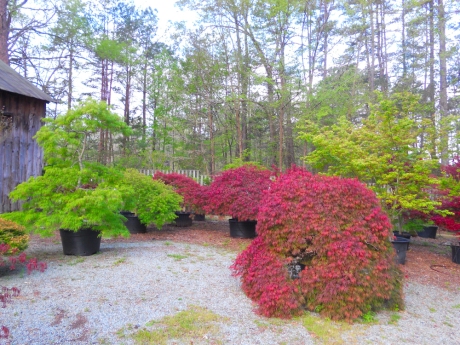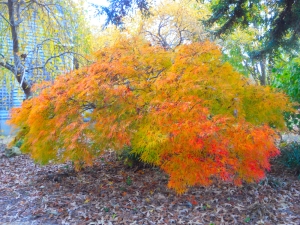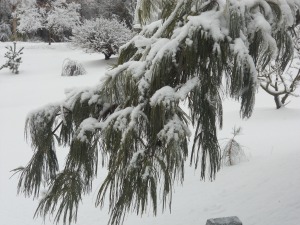Semi-retirement!
August 26, 2017
All of the trees are now gone. I’ll have some trees dug from the back field, Spring 2018. After a few months of relaxing, I’ll start up with planting geraniums, in January, with other varieties, following. I was surprised by the interest in annuals. Just are there are folks who collect Japanese Maples, and conifers, there are gardeners who love annuals.
Thank you all who help me sell about 4 years of plant material in less than one year. After it was all done, I only had to trash about 20 ‘ saleable’ plants which was far beyond my expectation.
The nursery looks a bit depressing now, without all the trees, but when I am ready to sell the nursery, I am sure it will be brought back into its own again.
Still, Many plants to choose from.
October 19, 2016
We have had a great response to our 50% off continuing sale. As soon as plants sell, I bring out more ‘from the back’. I have essentially 3 years of crops, so the supply continues to b e good. The largest trees are mostly available, as well as the very popular 1 and 2 gal plants, which are selling well, but I have many left to fill in voids. Some of the 3 gal and 7 gal Chamaecyparis obtusa and Chamaecyparis pisifera cultivars are sold out, but we have a good selection of some of the 2 gal and 7 and 10 gal sizes. During the week,(Wednesday through Friday, I can take more time and help with selections. Saturdays – especially in the afternoon are very busy.
Japanese maple selections change week by week. We have an excellent selection of 1, 2, 3 gallon maples all at great prices. This week, I brought out many more 5 and 7 gal cultivars.
Many have expressed sadness for the ending of Architectural Trees as they have known it, but are excited about the new focus – ‘Accent on Annuals’.
Thank you!
September 18, 2016
The response to my semi-retirement announcement has been overwhelming. Never had I anticipated so many people would come out to the nursery. Of course, the 50% off motivated people, but I realised that many came to say goodbye and thank me for creating Architectural Trees. Sometimes I forget how unique the setting is, and how the experience of shopping is different from most other garden centres. I only wish I could spend more time with the visitors but recently the crowds ( yes crowds!), have prevented me from doing so. The power of social media in announcing these changes cannot be underestimated. Thank you, Helen, Gene, and Lars for spreading the word. This ‘sale’ will continue all fall until all the plants are gone.
Each week, I will bring out more plants from ‘the production’ area to refill as much as I can. I will try to update the inventory list each week as well.
Thank you for your patience, as I realize that some of the wait times to check out were longer than I would have liked.
And finally, Thank you for your friendship over the years.Many of you I have seen every spring and fall each year, and I have gotten to know you and your garden which has always been one of the benefits I gained from having the nursery. Thank you also, for your encouragement in my decision to grow annuals in the future. Annuals, as a plant category, has been almost maligned from some, as a legitimate group to explore and grow.There are so many incredibly beautiful new forms not currently available in our market, and to be able to figure out how to grow them well, is a challenge I look forward to.
Semi-retirement…
September 3, 2016
Ever since I was about eight years old, I knew I wanted to have a nursery. In fact, I still have a tiny 2 inch by 4 inch 4 page ‘catalog’ of offerings. After being a clinical psychologist for 18 years, and after JC Raulston’s untimely death, I made the plunge and started my nursery ‘Architectural Trees’. Over the past 18 years, I have enjoyed almost everything about starting, and running what turned out to be a hobby business. I enjoyed the relationships with the other nursery growers, vendors, landscapers, and my customers, many which turned into friends over the years. I enjoyed being able to learn how to graft, propagate, prune and grow woody plants into respectable offerings to both the general public and landscapers. I enjoyed teaching grafting and pruning and a number of other topics in our Education Center – a converted tobacco barn.
I almost always had at least one employee, and several of them became relatively long-term workers. Many days we worked side-by- side, and it was enjoyable to learn about them and their world.
Almost every year, I took a trip to the nurseries in the Portland Oregon area, and saw what was coming into the trade as their nursery trade due to the concentrations of nurseries, and climate had some of the countries best nurseries.
Getting up in the middle of the night in February to knock off snow from the unheated greenhouses was no fun, nor was attempting to pot up bare root trees in the snow one year. Destroying trees infected with ambrosia beetle also was no fun. Only a few customers were unpleasant and unreasonable- I can think of only three in all those years, so I feel lucky in that department. Intentionally offering no guarantee – and going against the Industry mandate, allowed us a bit of room to teach plant care, and responsibility and placed reality squarely in the picture.
Now 63, it is time for a change. My health has some issues that though not immediately life-threatening, requires more attention and my energy level is noticeably lower. Woody plants require 12 month care. My semi-retirement plan is to actually grow annuals, herbs, and other interesting plants that I can grow in a 5-6 month cycle. I will continue the blueberry operation in July, but this will allow me to take more time off and enjoy time away from the nursery.
I have accumulated many unusual and garden worthy plants over these years. My plan is to sell ALL of them this Fall if possible. All plants are discounted at 50% listed price. We will be selling 1 year old Pinus thunbergi cultivar grafts to 20 ft tall Fagus sylvatica ‘Purple fountain’. I will not ‘dump’ plants on the market – I would rather throw them away, but this 50% off sale will allow gardeners, landscapers, other garden centers and speciality nurseries to access some remarkable plants at a great price.
No sales prior to 9/14 and thereafter we are open Wed- Sat 9 to 4pm. No need to rush, as we have many plants in the back and the offerings will change each week, as we replace the plants that sell. We ask that you pick up your plants within 10 days (unless the plant is rooted in, and it is best to wait for leaf drop).
Obviously, I have mixed feelings about this change but I can already feel some relief, and I am looking forward to learning new crops and having more time to spend in the Adirondacks of NY State which I love as well as the NC coast.
John Monroe
Up-date on Freeze.
May 11, 2016
I thought I should write a follow-up on the freeze we had last month. Many of my predictions came to be correct, but not all. The mulberry, fringe trees, black locust and gingko all lost all or essentially all of their new growth. All have re-flushed and will do well enough this year. Most of the Japanese maples that were damaged also have reflushed. A beautiful Acer palmatum Rhode Island Red has come back weakly, but should survive. Magnolias (deciduous ) did poorly and have just formed tiny buds that should eventually fill out the trees. One tree that may succumb is a 15 ft tall Picea smithiana that was in a stage of new growth that lost of the buds in the freeze. For the entire tree, I have only found two small shoots that are active. What happens to a tree that cannot grow? I am assuming it will die.
Blueberries did a bit better than I had anticipated. The early and midseason varieties fared pretty well with my estimate of a 20% loss of berries. The late variety, Tif-blue lost the most as these bushes were in flower stage. Approximately eighty percent of these berries are lost.
Spring is now mid-late spring and the evidence of the freeze is lessening and will shortly be just a memory that becomes just part of what it means to be a nurseryman.
Spring Freezes!
April 11, 2016
 April 15 th is the date I use to indicate the last possible Spring freeze for the nursery and my garden. So the two freezes we had on 4/5 and 4/9 were well within that parameter. Temps at or below 28 and essentially no wind, is the usual condition for devastation, depending on species, cultivar, and placement in the nursery/garden. Covering plants with thermal blankets, or even bed sheets,or bringing them into unheated shelters works well, but with so many plants it is not possible for me to protect all. A sort of triage occurs with the most valuable getting the limited protection available. The blueberry field also is a concern, as the earlier warm weather in late December and then in February had the bushes well-advanced – perhaps two weeks ahead of schedule.
April 15 th is the date I use to indicate the last possible Spring freeze for the nursery and my garden. So the two freezes we had on 4/5 and 4/9 were well within that parameter. Temps at or below 28 and essentially no wind, is the usual condition for devastation, depending on species, cultivar, and placement in the nursery/garden. Covering plants with thermal blankets, or even bed sheets,or bringing them into unheated shelters works well, but with so many plants it is not possible for me to protect all. A sort of triage occurs with the most valuable getting the limited protection available. The blueberry field also is a concern, as the earlier warm weather in late December and then in February had the bushes well-advanced – perhaps two weeks ahead of schedule.
This set of freezes turned out to be about the top two worst freezes in the almost 20 years I have been doing nursery work. It is still too early to assess the extent of the damage but early observations suggest that some trees will have to completely re-foliate, as all the new growth was cut back. Mulberry ( Morus alba), Fringe tree ( Chionanthus virginicus and retusus), Magnolia, Black locust ( Robinia) and some of the most exposed Japanese maples (Acer palmatum and japonicum ) were among this group. Gingko had slightly less damage. Conifers such as Spruce ( Picea) and some of the Pines (Pinus) were just breaking bud, and so many had not opened enough to have exposed soft tissue. Among the pines, the Japanese White ( P. parviflora) and Japanese Red (P. densiflora) had long candles that were bent over in the morning but seemed to recover to normal position by the next day.
The deciduous trees have secondary buds that in several weeks time,will begin to swell and eventually, develop into shoots. This growth never seems as vigorous as the initial spring flush, and in Japanese maples, the lovely branch pattern that develops from the normal bud break is altered, and sometimes the growth appears stubby. This can be corrected to some extent by careful pruning.
Obviously these trees are stressed which can make them more susceptible to ambrosia beetle. Keeping the defoliated trees on the dry side can help as the beetle is attracted to water-logged situations. Ambrosia beetle was not much of a problem this year, and the first brood is finished.
The blueberry bushes were filled with tiny berries. Most of the flowering were finished, especially on Premier and Climax the two early varieties. We had irrigated ( drip) the day before the freeze to moisten the soil in the hope that the soil would warm up more during the day and thus release even more heat back up in the night during the freeze. It is too early to know what damage the berries might have sustained.
How do I cope with the freezes other than doing what I can? I tell myself something a friend once told me ” Nature gives and she takes away”. This is one of the ‘takes away’. You accept it and realize that by choosing nursery work, you are accepting that contract. Now that the extended forecast does not show any more freezes, plants can be moved from the greenhouse ( where it has been getting too hot lately), and tender plants can be potted up and put into their position to grow on this year. Last year pine grafts in one gallon are ready to be shifted into two gallons, so the roots have room to grow and help those candles grow the most. So, I guess what I am saying that there is so much to do. The focus becomes what needs to happen as now that the freezes are over, we will always be behind until late fall.
Spring Opening! March 12, 2016
February 23, 2016
It is that time of year again, the smell of fresh hardwood mulch, Balled and burlapped trees unloaded from the trucks that make the long journey from Oregon, selecting the plants that we have grown here, that are now ready for sale, and seeing familiar faces ( and some new ones!) and long-time friends who come to visit the nursery and perhaps add another element to their garden.
We are among the Durham County farmers who are going to be selling at the new Durham Roots Farmers’ Market at Northgate starting April 16th. Unlike the other area Farmers’ Markets, this market will offer only the three ‘P’s : Protein, Produce and Plants. All have to be grown Durham county ( or Durham City). We are growing herbs and some bedding plants as well as our other usual plants- grafted conifers, japanese maples etc., to sell at this market. You may remember Chuck, who used to work here years ago – he will be selling at the new Market most Saturdays.
Our inventory list is getting updated so please check it soon to see what we will have for sale.
Winter Classes 2016
November 19, 2015
Pruning Class : Once again we will be offering a hands-on pruning class led by John Monroe, owner of Architectural Trees. The class is being offered 1/9/2016. The class is from 1pm until 3:30, held rain/ snow or shine, and is outside. How to look at and determine the singular beauty of a tree and how to bring it out by making pruning decisions is a focus of this class. Students need to come to class with by-pass pruners. Japanese Maples, and conifers will be some of the trees that we will learn about.
Fee: $45 paid in advance. Six students per class ( we will fill up the afternoon class before opening the morning class ).
Intensive Workshop for Intermediate or Advanced Gardeners , “Exploring Creativity, Gardening and the Self” This all day workshop held inside, is facilitated by John Monroe. Using structured exercises, and group process, the participants will have an opportunity to learn more about what gardening brings to their lives, how they tap into their creativity and perhaps, recognize some new connections within themselves that were ready to be made. Not a therapy group, however, an openness to one’s history and how gardening fits into it will be welcomed and respected. Saturday January 16, 9 -4 pm. Light breakfast and healthy snacks are included, bring a bag lunch. Five participants only. Fee is $150 for the day, paid in advance.
Designing with Fall color in mind.
November 14, 2015
John Monroe will give a presentation on Saturday November 14 at 1pm on Garden Design with Fall color. The presentation will be in the nursery’s Education Center. There is no fee.

Acer palmatum ‘Viridis’ 30 years old
Fall Conifer Series – John Monroe presenter
October 6, 2015
There will be three presentations on Conifers during October at Architectural Trees:
Saturday October 10 1pm – Pines for the Landscape
Saturday October 17 1pm – Hinoki cypress – size, shape and colors!
Saturday October 24 1 pm – Spruces
Each presentation will be held in the Education Center at Architectural Trees and last for about 30 – 40 minutes. Free of charge. 

